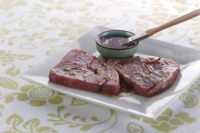Almonds and Chocolate
Science explains how almonds and chocolate are made for each other.

Why do chocolate and almonds work so well together? A perfect combination of their common flavor compounds and distinctly contrasting textures.

Consumers love the bursts of sound associated with the friable crispness and intermittent crunchiness of almonds against the backdrop of chocolate. This holds, whether the nuts are whole, in pieces or ground.


Almonds and chocolate, valued separately for their taste and texture, are treasured even more when combined. Whether enrobing almonds in chocolate or pairing chocolate chips and almonds or combining the two flavors in a beverage—such as chocolate-flavored almond milk—their common flavor components suffuse to delight taste buds, even while their unique molecular architecture creates complementing, sensual textures.
The taste of chocolate, intensely redolent of childhood memories, is affected not only by the kind of chocolate (i.e., milk or dark) and how it was made, but also by whatever is consumed alongside it. However, bittersweet characteristic chocolate notes seem to pop with every bite that includes the almond.
Chocolate owes its prized aroma and flavor to a legion of volatile and non-volatile compounds inherent in cocoa, and others formed during the course of its manufacture. Almond starts out delectably sweet, right from the tree, and develops a complex, signature taste characteristic, based on how it is prepared—raw, roasted, toasted, blanched or fried.
In the realm of culinary pleasures, chocolate perennially reigns supreme, while almonds are universally the most popular tree nut. With chocolate, instantaneous gustatory reactions tend to be largely about the prominent flavor notes—sweet, bittersweet, dark or milk. When combined with almonds, chocolate’s volatile compounds—ketones, pyrazines, terpenes, acetyl pyrroles and benzaldehyde, plus 100 other minor aromatic components—intermingle with the furans, trimethylpyrazine, terpenes, pyrroles and benzaldehyde of almonds—to create a tapestry of flavors that rates higher enjoyment levels than the sum of its parts.
A prevailing school of thought (via www.foodpairing.com) suggests that combining flavorful foods which share common, major volatile flavor compounds reinforces and heightens the characteristic notes of those components and “stands the mixture in good stead.” Chocolate and almonds are believed to work so well together, because they have a number of flavor compounds in common.
Other researchers claim the distinct contrast in their textures is the real driver of hedonic rating when chocolate is combined with almonds: The smooth texture of chocolate is broken up by the crispy crunchiness of almonds, and chocolate’s viscosity affects the speeds at which the different flavor molecules reach the flavor receptors. A combination of both paradigms is more likely.
Chemistry governs how the astringent cacao bean becomes flavorful cocoa—which then evolves into a hedonistic chocolate—and how the tender, crunchy, mild-flavored green almond grows up to be a crunchy raw almond. Upon heat treatment, the latter transforms into sensually crisp almonds. But, it is a combination of physics and the two ingredients’ respective mechanical attributes that make them combine so perfectly.
In other words, great chocolate deserves great crunch. Acoustic and mechanical properties greatly influence consumer appeal, buying decisions and eventual consumption. Consumers love the bursts of sound associated with the friable crispness and intermittent crunchiness of almonds against the backdrop of chocolate. This holds, whether the nuts are whole, in pieces or ground.
Understanding how nuances of flavor and texture interplay is especially valuable when designing almond and chocolate products for the global market. Ethnic differences and cultural preferences influence cuisine even more than chemistry. The Western cuisine trend of using “ingredient pairs that share many flavor compounds” suits the delectable duo. East-Asian styles that tend to avoid compound-sharing ingredients—but use various textures to titillate the senses—will be influential in other regions of the world.
Meanwhile, making favorite foods healthier requires strategic selection of ingredients and recipe formulation to maximize flavor release and product texture. In this case, the proven satiety-inducing protein and potent nutritious profile of almonds can do even more for the reputation of chocolate.
Looking for a reprint of this article?
From high-res PDFs to custom plaques, order your copy today!








